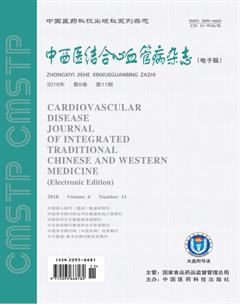外周血紅細胞分布寬度、中性粒細胞百分比與冠脈病變程度關系分析
周志宏 高雯 吳昊
【摘要】目的 探討紅細胞分布寬度(RDW)、中性粒細胞百分比水平與冠狀動脈病變程度的關系。
方法 選擇2016-03~2016-07于本院行冠狀動脈造影確診的冠心病155例,49例冠脈造影正常的作為對照。根據冠心病病人的Gensini積分分組,A組:0
【關鍵詞】紅細胞分布寬度;中性粒細胞百分比;冠心病;冠脈病變程度
【中圖分類號】R542.22 【文獻標識碼】B 【文章編號】ISSN.2095-6681.2018.11..03
Study on the relationship between peripheral blood red cell distribution width, neutrophil percentage and the severity of coronary artery lesion
ZHOU Zhi-hong1,2, GAO Wen2*, WU Hao2
(1.Baotou Medical College,Inner Mongolia Baotou 014040,China;2.Emergency Department,Bayannur Hospital,Inner Mongolia Bayannaoer 015000,China)
【Abstract】Objective To study the relationship between red blood cell distribution width, neutrophil percentage and the severity of coronary artery lesion.Methods The study included 204 patients, who received coronary angiography from March to July 2016 in in Bayannur Hospital. Patients were divided into negative group 49 cases and positive group 155 cases. The severity of coronary artery lesions in positive group were evaluated by Gensini score: A group(0-30); B group(31-60);C group(>60).Peripheral blood RDW level and neutrophil percentage were compared among groups.Results The RDW and neutrophil percentage in positive group were significantly higher than those in negative group, and the difference was statistically significant(P<0.05). The RDW and neutrophil percentage are associated with Gensini score in positive group(r=0.12 P<0.05;r=0.23,P<0.05).Conclusion The RDW and neutrophil percentage in positive group were significantly higher than those in negative group. There are obvious relevance of RDW and neutrophil percentage to the severity of coronary artery lesion.
【Key words】Red blood cell distribution width;Neutrophil percentage;Coronary heart disease;The severity of coronary artery lesion
冠狀動脈粥樣硬化性心臟病(coronary heart disease,CHD)的發生機制是一個多因素的過程。炎癥在從開始到動脈粥樣硬化的各個階段都起主要作用,并且在血栓形成中起作用。白細胞計數及其亞型已被作為預測不良心血管預后的炎癥性生物標志物進行研究[1]。本文要探討中性粒細胞百分比與紅細胞分布寬度在CHD血管病變情況的關系,為在臨床工作中用最簡單的方法早期識別CHD的高危病人。
1 資料與方法
1.1 一般資料
選取2016-03月~2016-07月在我院行冠脈造影的住院病人208例,由于數據缺失,實際204例,其中正常對照組49例,(男27例,女22例);冠心病組155例(男99例,女55例)。排除貧血病人,其中男血紅蛋白<120 g/L女血紅蛋白<110 g/L;血液系統疾病;感染或全身炎癥、甲狀腺異常、嚴重肝腎功能異常和惡性疾病。收集臨床信息包括病人年齡、空腹血糖及血清高密度脂蛋白、低密度脂蛋白、外周血常規檢查等。(1)外周血常規采用(Sysmex XN9000全自動血細胞分析儀)檢測。(2)生化指標的分析采用全自動生化分析儀(羅氏cobasc 701)進行檢測。該研究獲得巴彥淖爾市醫院倫理委員會批準。
1.2 方法
冠脈造影:采用美國 GE Innova 3100-IQ 數字減影C形臂X線機。冠脈造影過程:由有資質的介入醫師操作,用以判斷冠狀動脈有無病變方法采用Judkins法經橈動脈或股動脈進入,穿刺后插至冠狀動脈開口,選擇性地將造影劑注入冠狀動脈,記錄顯影過程。行選擇性多體位左、右冠狀動脈造影。左冠狀動脈造影采用5個體位,即右前頭位、左足位、蜘蛛位、左肩位、正頭位;右冠狀動脈造影采用2個體位,即左前斜位、右前斜位。CAG示腔徑狹窄>50%為病變。采用Gensini評分[2]確定冠狀動脈粥樣硬化的嚴重程度:將病變血管分為左主干、前降支、回旋支及右冠狀動脈。對每支血管病變程度進行定量評定:狹窄<25%計1分,26%~50%2分,51~75%計4分,76%~90%計8分,91%~99%計16分,100%計32分。不同節段冠狀動脈乘以相應系數:左主干病變×5;左前降支近段×2.5;中段×1.5,遠段×1;第一對角支×1;第二對角支×0.5;左回旋支近段×2.5,中段×1.5,遠段×l;鈍緣支×0.5;右冠近、中、遠段及后降支均×1。最終積分為各分支積分之和。
1.3 統計學方法
用SPSS 17.0軟件統計包,以“x±s”表示計量資料,采用t檢驗;以百分數(%)表示計數資料,采用x2檢驗;以P<0.05為差異有統計學意義。
2 結 果
CHD組在年齡、甘油三酯、中性粒細胞百分比、紅細胞分布寬度上高于對照組,差異有統計學意義(P<0.05),見表1;中性百分比、紅細胞分布寬度在按照Gensini積分劃分的A、B、C三組上差異有統計學意義(P<0.05)。經過相關分析檢測:冠心病組RDW、中性粒細胞百分比水平與Gensini積分呈正相關(r=0.12;r=0.23)。外周血紅細胞分布寬度、中性粒細胞百分比對冠心病診斷有預測價值,并且與冠狀動脈血管狹窄程度具有正相關性。
3 討 論
RDW是衡量紅細胞大小異質性的指標,通常用于貧血的鑒別診斷。近年來,RDW作為多種心血管疾病的風險標志物的作用越來越受到關注。Nagula P [3]等人通過分析胸痛病人的RDW與血管造影Gensini評分與冠脈病變嚴重程度具有相關性。有專家[4]指出,與高敏C反應蛋白(hs-CRP)相比,紅細胞分布寬度(RDW)是冠心病(CHD)死亡率的更好的預測指標,因為RDW可能反映機體綜合應激機制包括氧化應激,組織缺氧,神經-體液活動,內皮功能障礙和慢性炎癥。Kara?a?larE1[5]等人回顧性分析291例因心絞痛樣胸痛而行16層CCTA的病人資料CAD病人RDW水平顯著高于正常冠狀動脈。RDW對動脈粥樣硬化影響的可能機制有:(1)由于抑制Epo基因轉錄導致不成熟的紅細胞增多而導致貧血;炎癥和促炎介質導致促紅細胞生成素減少也可導致貧血;(2)RDW增加提出的另一種機制是氧化應激,氧化物還可激活轉錄因子促進炎癥反應中細胞因子如白介素6的表達,加劇炎癥反應,促使紅細胞分布寬度升高。Oxidative發現氧化應激同時生成氧化低密度脂蛋白,加劇動脈粥樣硬化[6]。Tziakas等[7]研究發現紅細胞分布寬度值與紅細胞膜膽固醇水平相關,紅細胞膜膽固醇水平升高會導致紅細胞可變形性削弱,從而影響血液循環中紅細胞的壽命,加劇紅細胞更新頻率,導致紅細胞分布寬度值升高。
在本文中中性粒細胞百分比在CHD組較正常人高;在CHD病人中,隨著冠脈病變程度加重,中性百分比與之有相關性。相關研究[8]表明,白細胞亞型對冠心病的診斷價值甚至比高敏C反應蛋白等炎性標志物有更好的地位。其可能機制與炎性細胞如中性粒細胞通過介導炎癥對內皮細胞氧化損傷、蛋白水解,從而形成高凝狀態及誘發斑塊發生[9]。
在臨床工作中,尤其是對于急危重癥病人,早期識別疾病風險進行危險分層是在和時間賽跑,紅細胞寬度、中性粒細胞百分比是簡單、經濟、快速的檢查,在臨床工作中有一定指導意義。
參考文獻
[1] Barron HV, Harr SD, Radford MJ, et al. The association between white blood cell count and acute myocardial infarction mortality in patients ≥65 years of age: findings from the cooperative cardiovascular project [J].J Am Coll Cardiol,2001:38( 6):1654-1661
[2] GENSINI G G.A mo e meaningful scoring system for determining the severity y o f coronary heart disease[J].Am J Cardio l,1983,51:606.
[3] Nagula P1,Karumuri S2,Otikunta AN3,Yerrabandi SRV4. Indian Heart J. 2017;69(6):757-761.
[4] Loprinzi PD.Protein in predicting all-cause mortality and coronary heart disease mortality [J].Int J Cardiol.2016,15;223:72-73
[5] Kara?a?lar E,Bal U,Has?rc? S,Y?lmaz M,Do?an?zü E,Co?kun M,Atar?,Y?ld?r?rA, Müderriso?luH. Coronary artery disease detected by coronary computed tomography angiography is associated with red cell distribution width[J].Turk 2016;44(7):570-574.
[6] Zhang PY,Xu X,Li XC.Cardiovascular diseases: oxidative damage and antioxidant protection[J]. Eur Rev Med Pharmacol Sci,2014,18(20):3091-3096.
[7] Tziakas DN,Kaski JC,Chalikias GK,et al. Total cholesterol content of erythrocyte membranes is in creased in patients with acute coronary syndrome: a new marker of clinical instability?[J].J Am Coll Cardiol,2007,49(21):2081-2089.
[8] Barron HV,Harr SD, Radford MJ,et al.The association between white blood cell count and acute myocardial infarction mortality in patients≥65 years of age: findings from the cooperative cardiovascular project [J].J Am Coll Cardiol,2001;38( 6);1654-1661.
[9] 邱 峰,王 用,邢玉龍,史云桃.外周血中性粒細胞百分比與冠心病及冠狀動脈血管狹窄程度的相關性研究[J].中國臨床研究,2015;28(12):1600-1602.
本文編輯:吳宏艷

